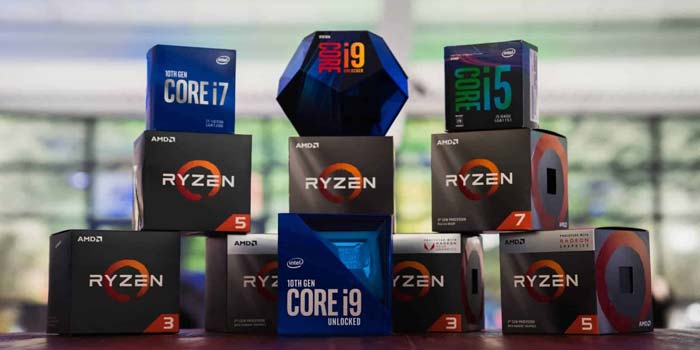With the rise of video-sharing websites like YouTube, video editing has become one of the most demanding skills. And this task places a heavy demand on the CPU as it is the most processor-intensive work.
Whether you’re a professional video editor trying to update your workstation or a content creator looking to buy the best CPU for rendering, we’ve got your back.
With all the various models out there on the market, sifting through all that noise is a daunting task. Our top list in this article will help you make this crucial decision easy.
Benefits of Using CPU for Rendering
When it comes to graphics processing, there are CPU and GPU options. Although they have a lot in common, there are some key differences.
The industry standard is the CPU rendering, as it is the first renderer to appear historically. Besides, there is widespread usage of CPU renderers. If your computer has a lot of memory and the CPU is high-end, it is better than GPU.
CPU can perform multiple calculations at the same time while GPU focuses all its computing abilities on a specific task. That’s why a CPU might be slower, but it provides higher image quality that’s devoid of noise.
In addition, the CPU is capable of handling much more complex tasks and has larger memory than a GPU. Its performance is stable as well as precise. Besides, it is easy to add more nodes with a CPU renderer than a GPU.
Our Top 7 Best CPU for Rendering and Animation
We have shortlisted and reviewed 7 of the best processors for rendering in this article. Have a look!
1. AMD Ryzen 9 3900X
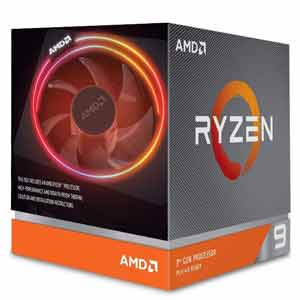
AMD’s 3900X processor comes with 12 cores and 24 threads with a good clock speed. This matters most while doing 3D rendering animations. This processor has more than enough cores for any core-hungry software.
The processor comes with a hefty base clock 3.8GHz. There is a fantastic option for boosting this score up to 4.6 GHz for more productive tasks.
Besides, this 3D rendering PC also has a 70 MB L3 GameCache. This will result in the smoothest high-end gaming and rendering experience. It means this processor could be called the best CPU for 3D rendering as well.
If your content-creating tasks require a fast CPU, then it can offer you such power efficiency and improvements that are nothing short of amazing.
This processor is also built on the same AM4 platform as the rest of the models in the series. However, 3900X refines the standout features, including overclocking and power efficiency. But the major standout feature is, as we mentioned, the massive core count.
It is rare to find 12-core CPUs in the consumer PC world. And since this processor supports multi-threading with 24 threads, you can run two different processing tasks in the same processor at once.
Highlighted Features
- The architecture is super-fast and ultra-efficient
- Compatible with X470 motherboards
- Support PCI Express 4.0
- Power consumption is relatively low
2. Intel Core i9-9900K Desktop Processor

One of the top rendering workstations and desktops for 3D modeling that you can get from the market now is the Intel Core i9-9900K. While being the flagship of Intel with a high-cost count, it more than delivers what you want it to deliver.
The i9-9900K comes with 8 cores and 16 threads to take care of all your heavyweight and intense workloads regarding 3D animation and rendering. This processor excels in all rendering and 3D animations, making it the best of both worlds for a CPU lover.
Despite having a lower core count than some of our AMD choices, its amazing single-core performance shows more than enough juice for handling processor-intensive tasks.
The 9900K chip features an integrated UHD 630 graphic engine with a sport unlocked radio multiplier. This helps make the overclocking a lot easy. Speaking of overclocking, it has a blazing fast base speed of 3.6 GHz. This acts as an absolute beast when it comes to computers for 3D modeling.
This processor can be overclocked to an incredible 5 GHz. But be careful in this case since you’ll need an additional CPU cooler to take care of the heat. However, it has the best thermal transfer already.
Another incredible feature that makes i9-9900K worth buying is the 16 MB L3 cache. This helps in faster and efficient processing.
Highlighted Features
- Absolute best overclocking ability
- Ultimate video editing performance
- Can perform both multi and single-threaded workloads
- Can be overclocked up to 5 GHz
3. AMD Ryzen 9 3950X
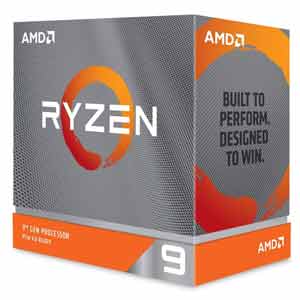
AMD brings out its ultimate threaded performance to the mainstream desktop industry with its Ryzen 9 3950X. You cannot but be impressed with its outstanding processor specifications.
Featuring unprecedented 16 physical cores that can run 32 threads at once, the 3950X is an absolute work beast, to be honest.
The high core count isn’t the only interesting new feature of this processor though. The Ryzen 9 comes packing its Zen 2 architecture spreading across 2 small 7nm chiplets tied together with Infinity Fabric. This results in unimaginable computing ability.
That’s not all! This processor also comes with AMD’s highest binned silicone – enabling a 4.7 GHz boost clock, while the other ones come with a mix of slow and fast cores. Its boost clock is 100 MHz. higher than the 3900X model.
When cooling comes into play though, this processor doesn’t come with one. It doesn’t feature a Wraith cooler like other AMD 3000 series models do. Its 105W TDP with four extra active cores require a robust cooling than 3900X. So, AMD recommends a liquid cooler with a 280 mm or larger radiator.
Furthermore, you don’t require a new expensive high-end motherboard for this processor because Ryzen 3950X can be slotted to nearly all existing socket AM4 motherboards with a little firmware update.
Highlighted Features
- Best CPU for 3D modeling due to 16 cores
- Excellent compatibility with existing AM4 motherboards
- Fastest processor for animation on the market
- Zen 2 architecture with two 7nm chiplets
- 4.7 GHz boost clock
4. Intel Core i7-9700K Desktop Processor
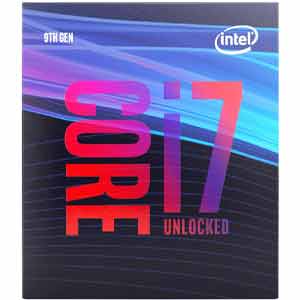
If you’re looking for an octa-core chip and you’re on a budget, there will be no shortage of great-performing CPUs. But Intel’s Core i7 is something extra. Core i7 9700K may not be the best CPU for rendering and animation on our list, but it is certainly one that offers you some formidable features.
This processor shows its rendering and animation capabilities with 8 cores and 8 threads with a 3.6 GHz base clock speed. Although not the most beefed CPU on the list, it can stand its ground for rendering works due to high boost speeds. This is worth considering as a PC for rendering tasks.
This octa-core processor comes with a 12MB L3 cache which is satisfactory according to our requirements. The maximum boost clock speeds up to 4.9 GHz which is 200MHz higher than its predecessor Core i7-8700K.
If you pair this CPU with a decent GPU and RAM, it will give you a stable 120+ fps on most animation titles at 2k resolution. However, we should also mention that it tends to stumble when it comes to 4K or higher resolution. But it will perform flawlessly for up to 2K for all encoding, decoding, and rendering.
Besides, the background works will not create much influence on the main performance. The 9700K has a dual-channel memory controller, which will max out at 128 GB.
This Intel Core i7 features integrated graphics, and it can come in handy while you are upgrading the BIOS. It also works as a lifesaver when the graphics card stops working.
Highlighted Features
- Excellent single-threaded performance
- Can handle complex gaming workloads
- Features an integrated graphics
- Great 1080p to 2K editing performance
5. AMD Ryzen 7 3800X
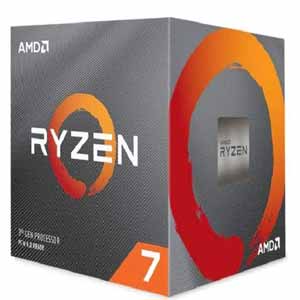
Although Ryzen 3800X is an upgraded version of its 3700X model, under heavy workloads, professionals will find that it has a 4% significant improvement in single-core performance.
When it comes to gaming, 3800X can compete with Intel’s i7-9700K high-end CPU benchmarks. But for single and multi-threaded tasks, the performance becomes out of the box.
If you’re a heavy user, such as doing animation works or movie productions, AMD’s 3800X will offer you a significantly good performance. Besides, it is also the best CPU for video rendering works, and you won’t find any dropped frames here.
But the overall basic components of 3800X take the basic shape from Zen 2 microarchitecture, similar to 3700X. However, it brings 15% more instructions per cycle (IPC) throughout. Besides, the 7nm processor turns it into a high-performance chip.
Due to this, 3800X is also 15% more expensive than other AMD models out there. But it won’t affect your price for value ratio since its memory controller has been significantly improved compared to others as well.
Besides, this model is well suited for use with the new PCIe 4.0-compliant X570 chipset that is absent for 3700X.
AMD Ryzen 7 3800X comes with a high TDP rating of 105W, almost double that of 3700X. But fear not, as it also features a Wraith Prism RGB cooler that can dissipate up to 124W when you crank the fan up high.
Highlighted Features
- Highly over-clocked compared to the predecessor
- Perfect processor for streaming and movie production
- PCIe 4.0 support and X470 compatibility
- Well suited with 400/300 motherboards
- A solid blend of single and multi-threaded performance
6. AMD Ryzen 5 2600X Processor
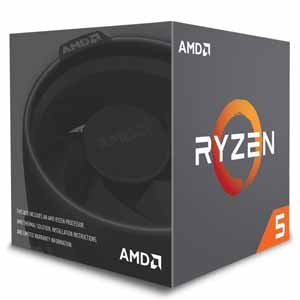
When you don’t want to break the bank and still look for the perfect all-rounder processor, get AMD’s Ryzen 5 2600X. Being one of the oldest CPUs on the market, it is also the most famous one that used to give a tough time to many high-end ones from Intel back in the day.
Although you can’t compare it to other high-end choices on the list, it has some decent specs at a lower price that you could check out.
Ryzen 2600X features 6 cores and 12 threads processor with 12nm Zen+ architecture. It has a base clock of 3.6 GHz that can be boosted up to 4.2 GHz at 95W TDP. So, you see, this processor sheds no less than 10 watts from the TDP. This means it will consume low power at all times.
This CPU also has an unlocked multiplier making overclocking a breeze. If you are one of those planning to install an aftermarket CPU cooler, this is the chance.
The Ryzen 5 2600X also comes with a Wraith Spire Cooler with pre-applied thermal paste. Although this 12mm fan can handle some overclocking, we don’t recommend you overclock with it too much.
Highlighted Features
• Plenty of cores and threads for a cheaper price
• Handles multi-tasking quite well
• Unlocked multipliers make overclocking easy
• Comes with a Wraith Spire Cooler
7. AMD Ryzen 7 3700X
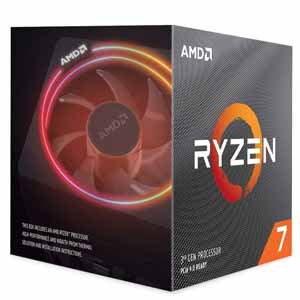
Another great generational update worth getting happy about is the AMD Ryzen 7 3700X. It is packed with the newest chipset architecture with minimum TDP. So, you see, this could be the best processor in the Ryzen 3000 series.
Although not the most powerful AMD processor, Ryzen 3700 is known as the poster child for AMD’s 3rd generation CPUs in the consumer market. Compared to its predecessor, it offers much more value for your money which also needs less robust cooling.
With this impressive processor, you’re getting 8 cores and 16 threads that also have a boost clock of 4.4 GHz. Like all other AMD processors from the Zen 2 series, Ryzen 3700X is also built on the smallest manufacturing node of 7nm. This consumes much less power and can perform better as well.
Offering a total of 36 MB of cache, which is known as GameCache to AMD, it boosts the overall gaming and rendering performance for experts. And as we said earlier, its low TDP of 65W can deliver quite a lot, making Ryzen 7 an absolute beast in multi-threaded workloads.
So, if you’re thinking of doing some video rendering and animation, then you’ll notice some performance boost with this 3700X compared to the predecessor 2700X.
In addition, this processor also comes with a Wraith Spire cooler. We can’t say it is the most robust cooler there is, but it can keep your processor under 80 degrees, even during heavy workloads.
Highlighted Features
- High price to performance ratio
- Includes a Wraith Spire cooler
- Very efficient and fast in rendering
- A general-purpose processor with low power consumption
Things to Consider Before Buying CPU for Rendering
When you need the best processor for animation and rendering, not all processors will be up to the task. There are a few specifications you need to keep in mind while picking the one you need.
Clock Speed
Although it might seem the easiest to look at, it is not that simple. When you’re building your new workstation for video rendering and animation, the clock rate becomes an essential component. This is measured in gigahertz (GHz), which is the operation speed of the chip. With higher clock speed, you get faster rendering.
Cache
Cache is a small amount of memory that’s closer to the CPU than RAM. It almost acts like RAM by temporarily holding data and instructions that CPU would reuse. Higher cache number also means faster computing.
Core Count
For any video editing purposes, the core count is an essential component. This is the basis of any workstation. A processor with more cores splits the workload between them and reduces the working hour, increasing efficiency.
Core count matters more than core speed when it comes to rendering because this task can be split into many small workable pieces and run parallelly on different cores.
Threads
The number of threads also directly affects the processing of previews, encoding files, and rendering. A thread is basically the number of processes a chip can handle at a time.
A processor with multithreading ability allows a single core to create two threads. And with more threads come better multitasking ability with enhanced performance for the PC.
CPU Cooler
The maximum amount of heat that a chip generates at stock speeds is its Thermal Design Power (TDP). Knowing this TDP, you can make sure that the cooler can handle this heat dissipation.
All PCs come with their fans, but a rendering processor requires a cooling system. So, while building your desktop for 3D modeling, ensure that the cooler is compatible with the processor.
Good GPU
Some software developers offload some of their processes onto GPU. So, if you plan on using that software like Adobe Premiere Pro, then ensure that the GPU matches the CPU to improve rendering times.
Power Consumption
Built-in graphics processor decreases power consumption. So, the best processor for rendering consumes moderate or low power that is good to curtail your electricity bills and keep the processor cool.
How Do 3D Graphics Work?
When the height, width, and depth are all present in a picture, it becomes a three-dimensional picture. Three-dimensional graphics is used to communicate complex and complicated stories as they contain much more information than 2D graphics.
3D graphics is a computer-generated image that goes through some major steps to create a 3D realistic scene.
These steps follow creating a virtual 3D world first, then determine which part of it will be shown on the screen. And then finally, it determines how every pixel on the screen will look to make the image as realistic as possible.
Now, this 3D graphics production workflow also falls into three steps: modeling, layout-animation, and rendering.
3D Modeling
Modeling is the process of forming a computer model that describes or is a representation of the shape of an object. Special software is used to manipulate points in virtual space to form the object.
Layout and Animation
It is a low-resolution 3D version of proxy models to be animated. And the animation is described as the temporal description like the movement of the object.
Rendering
It is the actual act of generating the 3D image. Here the software turns the model into a high-resolution image.
Frequently Asked Questions
1. How many CPU cores are needed for video editing?
For video editing and rendering purposes, no less than quad-core processors are required. But if the tasks are heavyweight and 3D rendering, then a minimum of 8 cores are needed.
2. How much RAM do I need for video editing?
A sufficient amount of RAM is necessary for video editing. If someone is engaged in motion graphics, having more memory will be more efficient. For this reason, 16 GB RAM is the minimum requirement for 4K editing; however, having 32 GB RAM will make the PC work much faster.
3. Which processor should I pick for 4K video editing?
There are so many processors on the market, and it can be hard to decide which one to pick for your own needs. While some offer more in one area, others offer more in other areas. But when it comes to 4K video editing, we recommend Intel Core i9-9900K and AMD Ryzen 3950X.
4. Which one is better between AMD or Intel?
Although many prefer AMD to Intel processors, giving the final verdict is difficult. AMD used to be the underdog until 2017, when they started introducing their 5000 Threadripper series.
That being said, Intel has always been in the leading position, and many fans have strong opinions about its brand. So, if your heart isn’t set on either, look for the most important specifications you need.
Final Words
Video editing requires a significant amount of processing power to ensure a smooth experience. With all the processors mentioned here, it is necessary to choose one that suits you most with regards to the specifications mentioned in our buyers’ guide.
Since the market is full of them, sometimes it can be confusing to pick the best CPU for rendering. We hope our short but extensive review has helped you in this task. Happy rendering!

